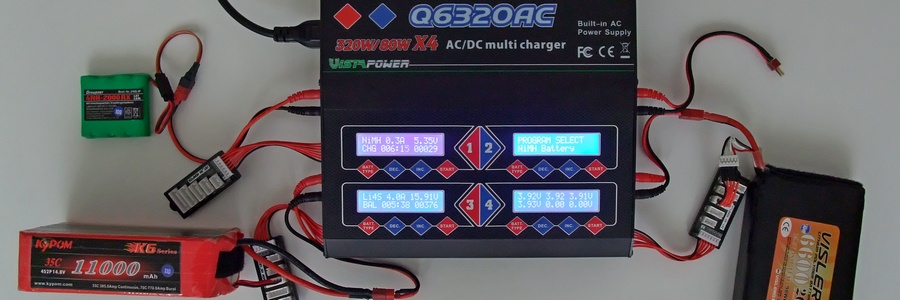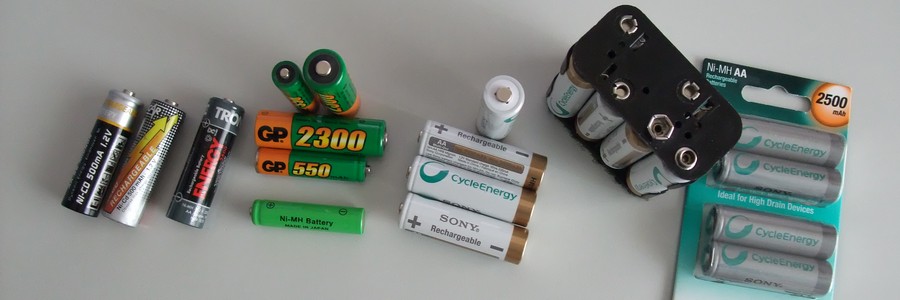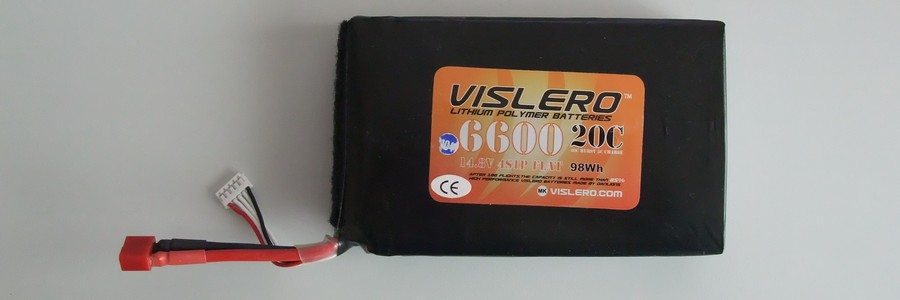Rechargeable Batteries
There are many types of rechargeable batteries: NiCd, NiMH, Pb, Li-Ion, LiPo etc.. Each type have their own characteristics and are suited for different purposes.
This article explains about power, energy, wear and care of NiMH and LiPo batteries.
Battery Types
| Type | Nominal voltage [V] |
Min voltage [V] | Max voltage [V] | Notes |
|---|---|---|---|---|
| Pb Lead-acid |
2.0 | - | 2.1 | Heavy, low capacity to mass ratio |
| NiCd Nickel-Cadmium |
1.2 | 1.0 | 1.4 | Memory effect |
| NiMH Nickel-Metal-Hybrid |
1.2 | 1.0 | 1.4 | - |
| LiPo Lithium-Polymer |
3.7 | 3.0 3.3 recommended |
4.2 | Delicate handling, high current possible |
Voltage, Current and Power
To make the electronics and motors of a device run it needs power. Power is the combination of voltage and current that the battery will supply.
A battery will consist of one or more battery cells. With multiple battery cells in a battery, all cells should be of the same type, same capacity and have been worn equally. In praxis it means that a battery is made from new battery cells right off the factory line.
If the cells are connected in series, one after each other, the voltage of the battery will be a multiple of cells and nominal voltage of a battery cell. As an example a LiPo battery may consist of 4 LiPo cells in series, this is called 4S. A LiPo cell is 3.7 V nominal, so the battery voltage U = 4 * 3.7 V = 14.8 V.
Alternatively it is possible to make a battery that has cells connected in parallel. The voltage will just be the voltage of one cell, but the capacity will be multiplum of cells and capacity of a battery cell. Parallel configuration is denoted with a P. If two cells are in parallel the max current of the battery will be double.
The Kypom LiPo battery shown later uses both serial and parallel cell structure. It is a 4S i.e. 4 cells in series, each of those cells are actually a unit of 2 cells in parallel to double the unit cell capacity, denoted 2P. Together the configuration is called 4S2P.
The max power that a battery can supply is then voltage multipled by max current. E.g. the Kypom LiPo 586 kJ is 4S and max 385 A.
P = U * I = 4 * 3.7 V * 385 A = 5698 W = ~5.7 kW

Power and Energy
These terms are not the same things, they are different like speed and distance are different. Power expresses how fast a battery can be discharged (emptied) or charged. Energy is the capacity of a battery or in layman term "quantity of electricity".
Energy can be calculated from power and time. If power usage is stable, energy is simply power multiplied by time: E = P * t.
Power is measured in watt (W). The base unit (SI unit) for time is seconds (s). Hence energy is measured in watt-seconds and this is called joule (J).
The time unit for electricity is often measured in hours (h), so the alternative to joule is to measure energy as watt-hours (Wh). As there is 3600 second per hour (= 60 mn/h * 60 s/mn) the relation between Wh and J is: 1 Wh = 3600 J.
Example: A motor uses 80 W, when running for 30 s it uses:
E = 80 W * 30 s = 2400 J = 2.4 kJ
Written in Wh: E = 80 W * 30 s = 80 W * 30 s / (60 s/mn * 60 mn/h) = 667 Wh
If the motor was running for 40 minutes:
E = 80 W * 40 mn * 60 s/mn = 192 kJ
Written in Wh: E = 80 W * 40 mn = 80 W * 40 mn / 60 mn/h = 80 W * 0.667 h = 53.3 Wh
Calculate from Wh to J, motor running for 40 minutes:
E = 53.3 Wh * 3600 J/Wh = 192000 J = 192 kJ
To calculate from J to Wh simply divide joules by 3600.
It is very common to mix up power and energy, people write W when they meant Wh. This problem can be avoided by always stating energy in the joule. In short write: Power in watt, energy in joule.
Capacity
The energy that can be stored in a battery is its electric capacity and is measured in joule (J) or watt-hour (Wh).
Link: Details about power and energyFor rechargeable batteries the capacity is often only expressed as a capacity of its current. To calculate the energy multiply the current capacity with the nominal voltage of the battery.
E.g. a Sony CycleEnergy NiMH AA cell with 2000 mAh. Such a cell has nominal 1.2 V and the capacity would be:
E = 1.2 V * 2 Ah = 2.4 Wh
Expressed in joule:
E = 1.2 V * 2 Ah * 60 mn/h * 60 s/mn = 8.64 kJ
C Rating
The C rating, or C factor, state the maximum of how fast the battery can be discharged (emptied) or charged in relation to its capacity. From the C rating the maximum current for the battery can be calculated.
C ratings are especially used for LiPo batteries, but a C rating can be calculated for any type of battery.
Note that C rating has nothing to do with celsius temperature.
It should be clear that if high current is drawn from a battery it will be emptied faster than if only low current is drawn. The C rating is based on hours of use. Using a battery at 1 C means battery will be emptied in 1 hours use. With 3 C factor it can be emptied in 20 mn. With 0.5 C it would last 2 h.
With the current capacity of the battery and its C rating the maximum current can be calculated as C rating multiplied by capacity of current.
E.g. the Vislero LiPo battery 4S with 6600 mAh and 20 C discharge.
Max current:
I = C rating * current capacity = 20 * 6.6 Ah = 132 A.
Time to discharge at max current:
t = 1 h / C rating = 1 h / 20 = 3 mn.
If there is only one C rating stated, this is normally the discharge C rating. In most cases the C rating for discharging is much higher than the C rating for charging, i.e. the battery can be emptied fast, but charging is slow.
E.g. the Vislero LiPo battery 4S with 6600 mAh, has 20 C discharge as max, but only 5 C for charging.
Max charging current:
I = C rating * current capacity = 5 * 6.6 Ah = 33 A.
Minimum time to charge:
t = 1 h / C rating = 1 h / 5 = 12 mn.
Sometimes LiPo batteries states two C ratings for discharging. A continous discharge and a burst disharge. It means that during a short time, some 10 seconds, the battery can be drained faster than its continous discharge. Typically the burst discharge will be 2 times the sustainable discharge. E.g. the Vislero 4S 6600 mAh battery state continous C factor as 20 C and burst as 40 C. It is recommended to NEVER use the battery at the burst discharge rate. In the best case it will just age the battery quickly, in a worse cases it will melt the battery or even worse battery will catch fire.
Remember the C ratings are maximum rates. A device powered by the battery should preferable discharge and charge the battery much slower than its C ratings allow. This will allow the battery to be used for many more charge / discharge cycles while retaining most of its maximum capacity after many cycles of charge / discharge. Going to the limits will age the battery prematurely.
Because the C rating is related to the capacity, it means that two batteries with the same C rating, but with different capacity, the battery with high capacity can also be discharged at higher current.
In many ways a C rating is a convoluted way to state the maximum current for a battery. It would be easier if batteries just stated maximum discharge current and maximum charge current.

Charging and Discharging
Discharging means to use the battery, i.e. taking the stored energy out of the battery.
To charge a battery is putting energy into the battery. Charging requires a special device that is made to handle the specific type of battery. E.g. a LiPo battery should only be charged by a LiPo capable charger, a NiMH or Pb charger cannot be used. LiPo charging is a delicate process and the batteries should be monitored.
Some battery chargers can charge many kinds of batteries, using different methods to charge different battery types.
E.g. EV-Peak Q6320AC can charge NiCd, NiMH, Li-ion, LiFe, LiPo and Pb battery types.

NiMH
A NiMH battery cell is nominal 1.2 V, fully charged it is ca. 1.4 V, empty at 1.0 V. Do not exceed these limits or you risk ruin the battery.
AA cell rechargeable batteries are now often NiMH type. Back in ca. 2000 these would be NiCd.
it is a problem that often there is no public datasheet for AA batteries. The batteries can typically be discharged at 1 C, but to be on the safe side discharge the batteries at max 0.5 C and charge at only 0.1 C.
E.g. Sony CycleEnergy NiMH AA cell with 2 Ah, which Sony has no public datasheet for, one should preferable just use 0.5 C, so max discharge at 1 A during 2 hours. Charging would be at 0.1 C which is max 200 mA during 10 hours, but in reality due to charge loss charge 12-14 hours.
GoldPeak known better as GP batteries does have public data sheets for their batteries.
GP Rechargeable NiMH batteries datasheet

LiPo
Lithium-Polymer (LiPo) have high capacity compared to their mass (weight). They also allow high discharge current, some well more than 100 A. However they are very delicate and can catch fire if not treated properly. Due to their high energy to mass ratio they are used for electric micro-copters and other remote-controlled aeroplanes and vehicles.
A LiPo cell is nominal 3.7 V, this is the "resting" voltage. When charging it is charged up to 4.2 V. When using the battery it is important that the a cell is never discharged below 3.0 V, otherwise it will ruin the cell. It is recommend to keep a clear safety margin and not discharge the cell below 3.3 V during use.
LiPo batteries consist of a number of cells in serial connection. E.g. a 4S battery is 4 cells in series, i.e. 4 * 3.7 V = 14.8 V nominal. When charged it is at 16.8 V = 4 * 4.2 V, and discharge to 13.2 V = 4 * 3.3 V.

LiPo require special charger, the delicacy makes it necessary that the charger can check the voltage level of each cell during charging. This is called a balanced charging. It is done using a secondary cable with n+1 wires for a n cell battery, i.e. for 4S it would have 5 wires. It has one wire connected to the negative pole of the first cell, acting like a GND level. Each of the other wire connected to in between each of the cells, so the last wire is same as the whole battery level. Using the wires on the balancer cable two and two, the voltage of each checked and specifically charged if needed. This assures that the voltage of the cells can be less than 1% different, within ca. 0.02 V absolute difference.
Often LiPo are stated to handle high charging but this could have an effect on the ageing of the battery. Recommended charging would be less than 1 C, better like 0.5 C, so full charging would take 2 to 3 hours.
As the LiPo become older with over 100 charge cycles, it takes longer and longer to bring the battery up to the top charge level. Because the charger has to be careful not to charge above 4.2 V per cell, it has to charge with low current towards the top. For older LiPo it can mean that the charger need more than 1 hour to charge with just 100 - 200 mA but still have difficult reach the end of charge.
If LiPo battery should be stored for weeks or month, it is best to charge them to their nominal voltage 3.7 V. As they will lose a bit in self-discharge over time it is best to charge them to slight above nominal voltage, to 3.8 V. Storing fully charged LiPo cells at 4.2 V is not recommended as this stress them and age them prematurely.
LiPo battery chargers usually have a menu item for storage charge. This will charge or discharge the battery to ca. 3.8 V, so they are ready for storage. Keeping batteries at storage charge also have the advantage that the battery needs less charge time for next usage at full charge.
Tags: Rechargeable batteries, charge, discharge
Page link: <http://foersom.org/HowTo/RechargeBatt.html>
Edited: 2014-09-20